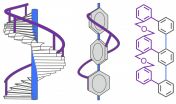INFORMATION:
Oliver worked with Erin Ash, assistant professor of communications studies, Clemson University; Julia K. Woolley, assistant professor of communication studies, Cal Poly; Drew Shade, assistant professor of English and communication, University of Cincinnati Blue Ash College, all former doctoral students in mass communications at Penn State, and Keunyeong Kim, a doctoral candidate in mass communications, Penn State.
Valuable movies and valued movies may be two different things
2014-11-12
(Press-News.org) Action movies may drive box office revenues, but dramas and deeper, more serious movies earn audience acclaim and appreciation, according to a team of researchers.
"Most people think that entertainment is just a silly diversion, but our research shows that entertainment is profoundly meaningful and moving for many people," said Mary Beth Oliver, Distinguished Professor in Media Studies and co-director of Media Effects Research Laboratory, Penn State. "It's not just types of entertainment that we usually think of as meaningful, such as poetry and dance, either, but also movies, television shows, video games -- or Youtube videos."
The researchers examined the critical and financial success of 582 films released during the past 30 years. To study the financial success of the movies, they used U.S. domestic gross box-office revenues. Critical acclaim was measured through awards and award nominations, along with online ratings from Internet sites, to determine how regular viewers and non-critics responded to the films. In addition to examining the genre, the researchers also recorded the way people described how silly, dark, thoughtful, or emotional the movies were on websites such as the Internet Movie Database.
Oliver said that action and adventure films tend to sell more tickets and have a better chance of being blockbusters, but they are less likely to earn popular or critical acclaim. On the other hand, movies that are more emotional and contain darker portrayals earn thumbs-up from critics and favorable ratings from viewers.
"What we see is that movies that encourage you to think may be seen as more moving and emotional, even if they tackle troubling issues or darker aspects of life," said Oliver. "You may not necessarily enjoy the movie, but you might deeply appreciate it."
The study points to the idea that entertainment can be more important than a simple diversion, providing audiences with ways to grapple with important and meaningful questions such as the purpose of life, according to the researchers, who report their findings in the online version of Mass Communication and Society.
Oliver said there are several possibilities to explain why highly acclaimed movies, though be deeply appreciated, do not fare as well as action flicks at the box office. Moviegoers may be less likely to see serious movies multiple times, for example. Thrillers and comedies may be more enjoyable with larger groups of people in bigger theaters.
"The difference between viewership and acclaim may be due to how people watch movies in theaters," Oliver said. "Movies that are more fun to watch with a large group of people -- like an action movie -- may be popular in that venue, but more serious movies might be more enjoyable when they are watched in smaller, more private settings."
However, that does not mean that audiences do not enjoy serious movies. Rather, they appreciate them on another level.
"They may not watch these movies over and over, but more serious films may be more valuable, in a sense, and also will be memorable to audiences," Oliver said. "They may stick with them for a longer time."
The researchers examined Academy Award and Golden Globe Award winners and nominees released between 1980 and 2010. To test acclaim from common audience members, they used ratings from IMDB and Rotten Tomatoes, two popular Internet sites for movie reviews.
While the researchers used the popular sites to compare the reactions of common movie fans to those of critics, they found that both groups generally agreed on the merit of films.
ELSE PRESS RELEASES FROM THIS DATE:
A tale of two seas: Last Ice Age has shaped sharks across Europe
2014-11-12
Shark populations in the Mediterranean are highly divided, an international team of scientists, led by Dr Andrew Griffiths of the University of Bristol, has shown. Many previous studies on sharks suggest they move over large distances. But catsharks in the Mediterranean Sea appear to move and migrate much less, as revealed by this study. This could have important implications for conserving and managing sharks more widely, suggesting they may be more vulnerable to over-fishing than previously thought.
The study, published in the new journal Royal Society Open Science, ...
Not all elderly Americans will surf to health
2014-11-12
Providing health information on the internet may not be the "cure all" that it is hoped to be. It could sideline especially those Americans older than 65 years old who are not well versed in understanding health matters, and who do not use the web regularly. So says Helen Levy of the University of Michigan in the US, who led the first-ever study to show that elderly people's knowledge of health matters, so-called health literacy, also predicts how and if they use the internet. The findings¹ appear in the Journal of General Internal Medicine², published by Springer.
Substantial ...
Learning languages is a workout for brains, both young and old
2014-11-12
Learning a new language changes your brain network both structurally and functionally, according to Penn State researchers.
"Learning and practicing something, for instance a second language, strengthens the brain," said Ping Li, professor of psychology, linguistics and information sciences and technology. "Like physical exercise, the more you use specific areas of your brain, the more it grows and gets stronger."
Li and colleagues studied 39 native English speakers' brains over a six-week period as half of the participants learned Chinese vocabulary. Of the subjects ...
Rice University program models more detailed evolutionary networks from genetic data
2014-11-12
The tree has been an effective model of evolution for 150 years, but a Rice University computer scientist believes it's far too simple to illustrate the breadth of current knowledge.
Rice researcher Luay Nakhleh and his group have developed PhyloNet, an open-source software package that accounts for horizontal as well as vertical inheritance of genetic material among genomes. His "maximum likelihood" method, detailed this month in the Proceedings of the National Academy of Sciences, allows PhyloNet to infer network models that better describe the evolution of certain ...
Mental health providers not well prepared to care for military veterans, study finds
2014-11-12
Most community-based mental health providers are not well prepared to take care of the special needs of military veterans and their families, according to a new study by the RAND Corporation that was commissioned by United Health Foundation in collaboration with the Military Officers Association of America.
The exploratory report, based on a survey of mental health providers nationally, found few community-based providers met criteria for military cultural competency or used evidence-based approaches to treat problems commonly seen among veterans.
"Our findings suggest ...
UT Arlington team says non-genetic changes can help parents or offspring, not both
2014-11-12
A new study from The University of Texas at Arlington biologists examining non-genetic changes in water flea development suggests something human parents have known for years - ensuring a future generations' success often means sacrifice.
Matthew Walsh, an assistant professor of biology, and his team looked at a phenomenon called "phenotypic plasticity" in the Daphnia abigua, or water flea. Phenotypic plasticity is when an organism changes its trait expressions or physical characteristics, or those of its offspring, because of external factors. In Daphnia, that can mean ...
A twisted world -- chemists build a molecular banister
2014-11-12
Chemists at the University of Basel in Switzerland have succeeded in twisting a molecule by combining molecular strands of differing lengths. The longer strand winds around a central axis like a staircase banister, creating a helical structure that exhibits special physical properties. The results were published in the renowned scientific journal Angewandte Chemie International Edition.
The chemistry of all substances is to a large extent defined by their spatial arrangement. Many molecules can be present in two forms (enantiomers), which behave like a person's right ...
In preschoolers, office test overestimates eye's ability to change focus, reports Optometry and Vision Science
2014-11-12
November 12, 2014 - In preschool-aged children, a simple test performed in the ophthalmologist's or optometrist's office greatly overestimates the eye's ability to "flex and focus" in order to see small objects clearly, reports a study in the November issue of END ...
Regulatory and scientific complexity of generic nanodrugs could delay savings for patients
2014-11-12
Nanomedicine is offering patients a growing arsenal of therapeutic drugs for a variety of diseases but often at a cost of thousands of dollars a month. Generics could substantially reduce the price tag for patients -- if only there were a well-defined way to make and regulate them. An article in Chemical & Engineering News (C&EN), the weekly newsmagazine of the American Chemical Society, details the challenges on the road to generic nanodrugs.
Matt Davenport, a C&EN contributing editor, points out that in small-molecule therapeutics -- aspirin, for example -- the active ...
Artificial retina could someday help restore vision
2014-11-12
The loss of eyesight, often caused by retinal degeneration, is a life-altering health issue for many people, especially as they age. But a new development toward a prosthetic retina could help counter conditions that result from problems with this crucial part of the eye. Scientists published their research on a new device, which they tested on tissue from laboratory animals, in the ACS journal Nano Letters.
Yael Hanein and colleagues point out that a growing range of medical devices has become available to treat conditions, including visual impairment, that involve sending ...



